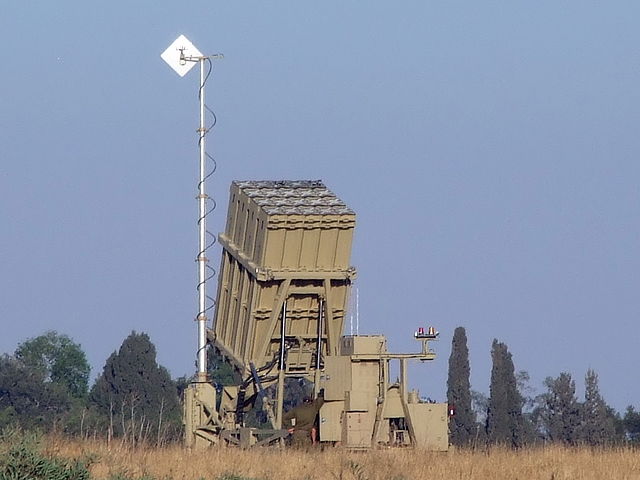by Marsha B. Cohen
Americans will soon get to see their taxpayer dollars at work when Israel’s Iron Dome anti-rocket system, funded largely by the US, is deployed during President Obama’s Israel visit.
Unless the inauguration of Pope Francis I causes an abrupt change in his itinerary , Obama will land in Israel on Wednesday, March 20. Immediately after an official welcoming ceremony at Ben Gurion Airport, Prime Minister Benjamin Netanyahu and President Shimon Peres will show him an Iron Dome battery, set up at the airport so the President won’t have to travel to a site where the mobile anti-rocket system is being deployed.
The Iron Dome system may well be the quintessential metaphor for US-Israel relations in general, and for Obama’s relationship with Netanyahu in particular, the love child of a sometimes steamy, often frosty and increasingly strained affaire de coeur between defense spending and domestic politics. According to outgoing Israeli Defense Minister Ehud Barak, Israel has already received $270 million towards the construction of Iron Dome and — despite the hand-wringing and wrangling over budget cuts in Congress — is slated to receive another $680 million, nearly a billion dollars on top of Israel’s usual $3 billion in annual US military assistance. These figures are corroborated by a Congressional Research Report published last March, which points out that Israel receives 60% of all American Foreign Military financing.
JINSA (the Jewish Institute for National Security Affairs) waxes rhapsodic about Iron Dome’s “affordability and effectiveness,” a claim that would make some of the system’s staunchest defenders blanch and its critics guffaw. Each interception costs $100,000 — two interceptors at $50,000 apiece targeting every incoming rocket that appears headed for a populated area of Israel — hardly “cost effective.” The American Israel Public Affairs Committee (AIPAC) also uncritically enthuses that “the Iron Dome missile defense system is now hailed as a groundbreaking innovation, an example of the technological prowess of Israel, and an embodiment of the unique relationship between the Jewish state and the United States.”
The hagiographic account of Iron Dome on AIPAC’s website is however both incomplete and seriously flawed:
The idea for Iron Dome arose after Israel’s 2006 war with Hizballah, in which more than 4,000 rockets were launched into the country’s north. As rocket fire from Gaza targeting southern Israeli communities also intensified, it became clear that a system was needed to defend against short-range rockets and missiles.
Not exactly. Last November, the Wall Street Journal offered a much more detailed account of Iron Dome’s origin. Brig. Gen. Daniel Gold, the director of the Defense Ministry’s Research and Development department, had gone ahead and decided on the development of Iron Dome, calling for proposals from defense companies for anti-rocket systems in August 2004 — two years before the Second Lebanon War. He did so without any authorization from Israel’s political leadership. It was not until after the 2006 “Second Lebanon War” between Israel and Hizballah that Prime Minister Ehud Olmert and Defense Minister Ehud Barak — under withering criticism for allowing Israeli civilians in non-border regions to come under rocket and missile attacks — backed Iron Dome, giving the project $200 million in December 2007. The rocket attacks during and since the 2008 invasion of Gaza (“Operation Cast Lead”) increased demand for a rocket interception system. The system went into operation in March 2011, shooting down its first rocket on April 7 and reportedly taking out 8 more rockets in the next three days.
According to AIPAC, by April 2011 “an Iron Dome battery was fielded outside the southern city of Beersheba and shot down its first rocket fired from Gaza. Since then the system has achieved an 85-percent interception rate and is constantly improving, as its developers enhance its accuracy and expand its range.”
Last week, Reuven Pedatzur, a highly respected Israeli security analyst who has been a sharp critic of the Iron Dome project since 2008 when he pointed out that billions had been squandered on the program, cited studies by missile defense experts that suggest Iron Dome’s successful interception rate may well be 5% or less — far below the 84% success rate cited by the Israeli Defense Forces and other defenders of the program. Pedatzur cites research done by three rocket scientists: Professor Theodore Postol, a world-renowned scientist and expert in missile defense and two other rocket scientists, Dr. Mordechai Shefer, formerly of Rafael, and a scientist he refers to only as “D.”, who recently worked for Raytheon, the manufacturer of the Patriot missiles. After investigating the performance of Iron Dome during Operation Pillar of Defense this past November, all three concluded that “Iron Dome’s rate of success did not come close to the figure of 84% as reported by the IDF”:
According to the three scientists, who conducted their research separately by analyzing dozens of videos filmed during the operation, most of the explosions which look as if they were successful interceptions, are actually just the self-destruction of the Iron Dome’s own missiles. The scientists point out that in every case the explosions, seen as balls of fire during the day and clouds of smoke at night, were round and symmetrical. In the case of successful interceptions, in which the incoming missile’s warhead is destroyed, there should have been another ball of fire or cloud of smoke. They also uncovered a strange phenomenon whereby the Iron Dome’s missiles followed identical trajectories, and self-destructed at precisely the same time. In some of the videos, it appears that the Iron Dome’s missiles made a very sharp turn shortly before self-destruction. That cannot be, say the scientists, as there is no way that the missile defense system could “remember” that it needs to turn in the direction of the incoming Grad missile a quarter-second before it self-destructs.
Pedatzur also noted that these scientists discovered 3,200 civilian damage reports that were filed for destruction caused by incoming rockets. Could the 58 rockets that the IDF admits were not intercepted by Iron Dome have caused so much damage? Compared with the damage from rockets during the Second Lebanon War before Iron Dome was deployed, Pedatzur considers that unlikely. Furthermore, Israeli police reports counted 109 cases of rockets falling in populated areas, twice as many as the number claimed by the IDF. Pedatzur compares the exaggerated success rate of Iron Dome to the initial 96% interception rate claimed for the Patriot missile system during the aftermath of the Gulf War. Professor Postol later found the Patriot success rate to have been zero.
Nonetheless, AIPAC has even bigger dreams for the future of Iron Dome: “Now that the Iron Dome has proven itself, Washington will have the ability to use it in its own defense efforts against short-range rocket threats in the Persian Gulf and South Korea.”
The real challenge — and achievement — of Iron Dome has been getting the US to pay for the anti-rocket system. The WSJ‘s Charles Levinson and Adam Entous report that Israel’s Defense Ministry approached the George W. Bush administration with a request for hundreds of millions of dollars for the system, only to receive a cold reception at the Pentagon. Experts voiced doubts about the system’s effectiveness and argued that even if it worked, such a system would be too expensive. (Most Israeli military and defense officials were also dubious.) A team of US military engineers sent to Israel by the Defense Department to meet with the Iron Dome system’s developers were unconvinced by the technology and skeptical about the prospects for its performance. They recommended that Israel adopt the American-made Phalanx system being used in Iraq.
In 2008, US Senator and presidential candidate Barack Obama visited Sderot, a town near the Gaza Strip that came under severe rocket attacks during Operation Cast Lead and whose residents were constantly running for cover from incoming Qassam rockets. Obama won the election and took office as President and shortly thereafter an Iron Dome prototype successfully intercepted an incoming rocket during its first field test. Colin Kahl, appointed by Obama to overseeing US military policy in the Middle East at the Pentagon, decided to reconsider the Iron Dome’s merits — military and political.
Having raised the hackles of Israel’s newly installed Prime Minister, Benjamin Netanyahu, by calling for a settlement freeze and prioritizing the Israeli-Palestinian peace process, Obama wanted to set things right with Israel. “Top Obama administration advisers saw supporting Iron Dome as a chance to shore up U.S.-Israel security relations and balance some of the political strains,” according to Levinson and Entous. In September, Kahl dispatched a team of missile-defense experts to reconsider Iron Dome. The team presented its findings to Obama a month later: “the team declared Iron Dome a success, and in many respects, superior to Phalanx. Tests showed it was hitting 80% of the targets, up from the low teens in the earlier U.S. assessment.”
In 2009, the US agreed to provide $204 million for the Iron Dome system’s development. The National Jewish Democratic Council pointed to Iron Dome as one of the means by which Obama had restored Israel’s Qualitative Military Edge — eroded during the Bush years. An additional $680 million over three years was allocated for the purchase of additional batteries in May 2012, during talks between Barak and US Defense Secretary Leon Panetta. Barak met with Obama’s new Secretary of Defense Chuck Hagel earlier this month, during which time Hagel was said to have pledged continued US support for Iron Dome. Israel eventually hopes to triple the number of Iron Dome batteries deployed in defense of military as well as civilian targets.
If Obama had favored funding an Iron Dome program for any other country, you can be sure that Republicans would be shrieking about the administration’s increasing of the deficit by borrowing funds to expend close to a billion US taxpayer dollars on a system with a success rate that been grossly exaggerated. Furthermore, as Walter Pincus of the Washington Post has pointed out, the US government has no rights to the Iron’s Dome’s technology, which is owned by Rafael Advanced Defense Systems Ltd., an Israeli government-owned, for-profit company.
Consider all this next week when you see Netanyahu and Peres showing off the Iron Dome to President Obama.
Photo: The Iron Dome CRAM launcher near the Israeli town of Sderot. Credit: Natan Flayer.






There are a couple of issues which Professor Postol seems to ignore that maybe you can address.
There were 5 Tzevah Adom alarms in Tel Aviv, all followed by explosions (either the Iron Dome or the Fajr-5). Were these “successful” interceptions, and if not, where did the warheads go? Tel Aviv is an urban area and the explosions that hundreds of thousands of people heard were either successful interceptions or 175 kg warheads striking the ground. Where is the damage of they were not intercepted?
Secondly when there is an incomplete interception (the entire projectile is not destroyed), there is resulting debris which falls and causes considerable damage. Doesn’t it make much more sense that the fallout of interceptions is more likely to result in the massive number of police reports about rocket damage? If the un-intercepted warheads were responsible for causing this damage wouldn’t there be impact craters INSIDE Tel Aviv?
Thirdly, why does Professor Postol conflate the Qassam, Katyusha/Grad and Fajr rockets? The majority of the rockets sent by Hamas, Islamic Jihad and the other militant groups in Gaza were Qassam which are not interceptable by the Iron Dome due to their very short flight time. Isn’t it perfectly logical that many of these damage reports are from Qassam rockets, which the Iron Dome has no impact on?
Lastly, Professor Postol endorsed the Iron Dome as a missile-defense system in a November 26, 2012 interview with MIT’s Technology review. http://www.technologyreview.com/news/507736/why-israels-iron-dome-missile-defense-system-actually-works/ What made him change his mind and why are media sources not asking him why this happened?
See my blog post at the following for more in depth and links to what I’ve referenced.
http://persophilia.blogspot.com/2013/03/why-criticism-of-iron-dome-may-be.html
Regards,
Morgan Carlston
Well as much as Marsha is trying to undermine the system, but the information she herself provided testifies against her. First, the cost of the rocket. Well it depends of course whether it hits the target, but even if does so even in 50% of the cases do you think that 100 thousand dollars is not a high price to pay for lives and property of the people targeted by the missiles. Mind you the missiles that this system is design to intercept are military style devices intended to cause widespread damage and a great number of casualties. I certainly believe that if Marsha or her family was at the receiving end of these missiles she would have changed her mind pronto.
Now about the effectiveness. I don’t know anything about physics of the rocket so I would not comment on the forms of explosions, but there are several facts in the article that make me doubt the conclusion about ineffectiveness of the system.
First, as every person with the slightest understanding in statistics will tell you, in order to draw conclusion about the entire population (i.e. performance) based on a sample you need to be sure that your sample is representative. Let’s assume that their conclusions regarding the explosions are correct. The experts watched dozens of films out of hundreds attempted interceptions. Are they sure that these dozens of films represent different events (especially since they claim that the interceptors always do the same turn). May be the films come from one faulty battery that was situated near the place where all the journalist were, hence the discrepancy between their “estimation” and IDF’s. May be failed interceptors by virtue of being longer in the air allow greater number of people to find their cameras to film them.
Second – damage reports. I imagine that they always tend to be very liberal estimation, because any kind of damage including debris (as pointed out in a previous comment can provide a reason to demand compensation). Besides as targets were the cities and Ashdod, Beer Sheva and Ashkelon are urban centers with a lot of high-rising buildings and they by the virtue of trajectories of these rockets are especially vulnerable, it makes sense that the number of the reports (or more exactly claims) are by far larger than the number of the rockets.
However and more to the point, the experts seem to take Israeli police reports seriously, so then why they disregard the police reports that they themselves cite. If police have reported 109 falls it is still, at least according to the numbers Marsha uses – (59 is 16%, than 109 is 30%), is a mind boggling 70% of interception rate.
Finally and most importantly, I myself don’t put a lot of trust in anything, but common sense. I don’t really know whether the reports either by police or by the claimants were doctored one way or another.
I look at the number that Israelis would not and could not doctor – the casualty numbers. According to what was published the number of rockets fired from Gaza was around 1450. In the war 4 Israeli civilians and two soldiers were killed. There is only one case when the civilians were killed within the cities (where Iran Dome was supposed to protect them). These numbers strongly suggest that the success rate was much higher than 5%.
I think considering that this is a young system still in the process of development it is really an achievement, especially in view of the fact there is no other operational system capable of intercepting even a single “Grad” type missile.
each of these proven ineffective missiles
takes food from american mouths. pity.
Postol’s claims of low success rate is refuted by the incontestable statistics of casualties and damages. In the 2006 Lebanon war and before Iron Dome existed, the barrage of 4000 rockets killed 53 Israelis. In other words, it took 75 rockets to kill one person. In operation Pillar of Defense the barrage of 1500 rockets killed 5 persons (a sixth person was killed from a mortar bomb which Iron Dome is not dealing with). In other words, this time it took 300 rockets to kill one person. The rockets were about the same types carrying the same warhead – mostly Grad rockets wth a small percentage of heavier rockets. The only factor that changed between 2006 and 2012 is the deployment of Iron Dome.
In fact, the effect of Iron Dome was even more significant: The rocket fire in 2012 was more concentrated, About one third of the rockets hit or were going to hit within population centers. In 2006, only abount one quater hit within population centes. When adjusted for this, the lethality of the rockets fire was diminshed by 80% – roughly the number cited by Israel for Iron Dome’s average rate of success.
The 4000 rockets in 2006 brought 30000 damage claims. Therefore with no Iron Dome, the 1500 rockets or 2012 should have resulted in 14400 damage claims. In fact only 3165 were posted – once more a reduction of 80%. Again, the only factor that changed was the deployment of Iron Dome.
Thus, both casualty and damage indicators refute Postol’s claims and support Israel’s published numbers.